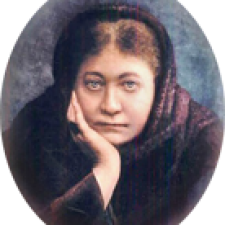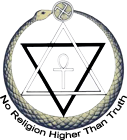Some Reflections on the Note, by Grigor V. Ananikian
about
"The Blavatsky/Tibet and Stanzas of Dzyan Connection."
By
Jean-Louise Siemons
Member of the Academy of Religions
Since the years 1990’s, when Paul Johnson demonstrated conclusively (in his opinion, at least) that Mme Blavatsky’s mahatmas were not the mythical “Masters of Wisdom” she had depicted, belonging to a no less mythical secret brotherhood of Tibet, but living human personages of her time, whose true identity could be ascertained, there remained to complete the picture by tracing the sources from which Mme Blavatsky had drawn her ideas, and even her doctrine.
This, the author (Grigor V. Ananikian) attempts to do in his note: “The Blavatsky/Tibet and Stanzas of Dzyan Connection“. There being, in his view, no occult School, no high Master to give her the teachings she later communicated to our world, he takes it for granted that H.P.B. did fabricate all, with elements found here and there, from her young days to the time of her public appearance.
Unfortunately, Ananikian’s thesis rests on no documented examples, no convincing demonstration, no literary reference. Like a detective, he “hypothesizes”, “assumes”, “suspects”, yet frequently tempers his affirmations with verbs like “may” (13 occurrences) or “seem” (4), along with “maybe” and “probably”. Nevertheless, he feels sure of his findings. More than once, H.P.B. is supposed to have “misread”, “misperceived”, or “misunderstood”, what she gathered here and there, or was “influenced” to accept. Thus H.P.B.’s case is finally easily judged.
Still, to any one moderately expert in Theosophy, who is willing to examine with an open mind the author’s demonstrations, while keeping in view all that he has learnt of H.P.B.’s life, and her writings, it appears in full light that Ananikian, with his preconceived ideas on the matter, is sadly ignorant of elementary aspects of the subject.
Both Johnson and Ananikian would like their readers to believe that:
- all was invented, or fabricated in what H.P.B. said, wrote in her mail, reported of her experiences,
- all was invented, or fabricated in the Mahatma Letters, in her literary master-pieces and other volumes.
In other terms, she had constantly deceived her public, attempting, with a singular perseverance and tenacity, to make believe things that were wrong, or entirely different from what she affirmed. To one truly conversant with Mme Blavatsky’s writings, the conclusion cannot be escaped, on the contrary, that the whole stands as solid piece of truth, that pleads for itself, even if one accepts that she was not infallible (as she herself declared).
Concerning her Masters (although she was ordered not to reveal certain of their secrets), why should we doubt her word when she wrote: “Our Mahatmas […] belong to no sect” (Collected Writings, VI, 38), their doctrine is surely not Lamaist-Buddhism (Coll. Writ. XII, 337). Being no Lamaists, they could not teach Lamaism. Hence why should “reasonable investigators” (including Grigor V. Ananikian) be surprised that “nothing in Tibet matches H.P.B. Yet nothing in India matches her views either” (an exaggeration, by the way, that could be considerably reduced). Alexandra David-Neel met in Tibet many kinds of ascetics and yogis who were not Lamaists. As to India, the Masters repeated in their letters to Sinnett: “we are not Advaitis” (p.58), “were never Advaitis” (p.288).
Although circulating freely through Tibet, India (even Europe), those Masters paid no allegiance to any “official” system, any known School. They often speak of themselves as disciples of esoteric Buddhism (Mah. Let. p.462), “which is nearly identical with the doctrine of esoteric Advaitis” (Coll. Writ. IV, 567). As to H.P.B., she claimed to have learnt from them, and expounded, some of the tenets of “the Aryan-Chaldeo-Tibetan doctrine”, as they call the “universal Wisdom-religion” (Coll. Writ. VII, 347). This accounts for the “northern origin” of her Theosophy. Obviously, Central Asia is the region that was the cradle of that esoteric Wisdom. (See also, Five Years of Theosophy, pp. 177-182, for H.P.B.’s Appendix to the article “[Brahminism On] The Sevenfold Principle in Man“).
Now, the difference with Ananikian’s views lies here:
For H.P.B., Central Asia was the place where the original doctrine was treasured by the Sages of the Fifth Race (many thousands of years ago, after the submersion of Atlantis). Hence, in the course of time, the various forms of religion were disseminated from the original focus, to become what an historical investigator attempts to discover, and study, in their exoteric (often distorted) manifestations (in which Ananikian fancies he is now finding the sources of H.P.B.’s inspiration).
An example of such subsequent evolution (and degeneration) is precisely the Bön religion, whose adepts are “the greatly degenerated descendants of mighty and wise forefathers”, while their rites are found to have “an undeniable connection” with the popular rites of the Babylonians (Five Years, pp. 177-8) (See also Coll. Writ. IV, 15fn : “the Bön” religion […] a degenerated remnant of the Chaldean mysteries”).
What H.P.B.’s Theosophy could have in common with that Bön tradition? What with Dzogchen (as now known)? And with the Nyingmapas (the “reddest” among the Red Caps) who, together with the Böns, opposed reforms of Tsong-kha-pa, the founder of the Gelug-pas (a real “incarnation” of the Buddha, held in great respect by the “Masters”)?
Now, “esotericism” does not necessarily means “heterodoxy”. There is not one Buddhism, but quite a number of Buddhisms (or, if one prefers, numerous forms, or Schools, of Buddhism, which could appear “heterodox” to each other). This diversity is due (among other causes) to the “silences” of the Buddha himself, on metaphysical tenets (as so many lacunae that his erudite successors attempted to fill up). Perhaps, if the Buddha were to come back, to complete his doctrine, he would appear “heterodox” to some. H.P.B.’s Masters did what could be done, precisely, to add, through Theosophy, what was lacking in many instances, thus revealing, under apparently heterodox forms, that which had been kept hidden in the Buddha’s public discourses.
As to “brotherhoods”, Central Asia is not the only region to be “replete with them” (in Ananikian’s words), as H.P.B. herself bore witness in Isis Unveiled, and many an article of her pen. In all her travels through the world, she had met and visited quite a lot of them, and sometimes she happened to be introduced into their secrecy (this, since her young days).
Her article “Lamas and Druses” (Coll. Writ. III, 176, seq.) is eloquent. There she points to a mysterious connection between the Druses and the Lamaists. She even alludes to the Sikhs (p.179), and to similar aspects between the religion of Guru Nanak and Buddhism. In all this (especially in what concerns the Druses), she seems to have a first-hand knowledge of what she speaks about. Could it be that after so many real encounters with fraternities scattered through the world, she invented the brotherhood of her Masters? Childish supposition.
Now, as concerns the “astral” (world and body), there is no necessity to invoke Central Asian sources, or even neoplatonic currents. The terms were taken direct from the French Eliphas Lévi’s abundant writings. But to imagine that H.P.B. learnt the existence of the “astral” from books, or religious traditions, is again childish. Before appearing on the public scene, she had learnt all the mysteries of the astral by experience and during her training with her Master, as she confessed in her private correspondence, even before her first published article or volume.
Is Ananikian so sure that Buddhists and Hindus ignore the existence of what Theosophy depicts as an astral body, during life and after death? A born Hindu, like T. Subba Row, had nothing to object to it. See his article: “Septenary Division in Different Indian Systems” (Five Years of Theos. p.185). For the post mortem Kâmarûpa, Hindus have words like preta sharîra, bhûta rûpa, etc. and the Tibetans speak of gyu-lu (written sgyu-lus) for “the immaterial body of the soul” after death (S. Chandra Das’ definition in his Dictionary).
As to the “feminine” presence in cosmologies, there is no need to turn to the Böns, or Central Asia. Mother Space, Aditi, is definitely Hindu; so is Mûlaprakriti, the eternal Root-Substance; and the Bhagavad Gîtâ has the famous verse (XIV, 3):
“The great Brahmâ is my womb (yoni = a very feminine term), in that I cast the seed”.
Finally, in spite of all his efforts, Grigor V. Ananikian does not prove his case. Whether or not Mme Blavatsky fabricated her Masters and their doctrine can hardly appear in light from his unconvincing demonstration, that falls to the ground, under scrutiny, like a castle in the air. As to the Note’s attractive title, promising some information on the Stanzas of Dzyan, the little (unpersuasive) Ananikian finds to say on them reduces the whole to a lure, void of all substance. And his insolent conclusion, deriding “the luridly Peter Pan-like fantasy of ascended masters” and their “believers” (the Theosophists who “want bedtime stories”) returns to the author, who fabricated his own bedtime story, for his personal gratification.

